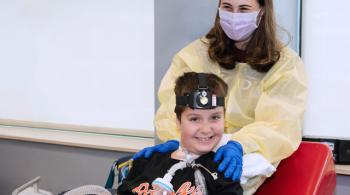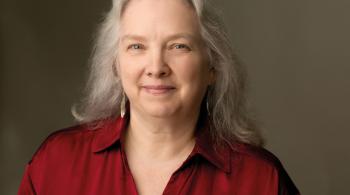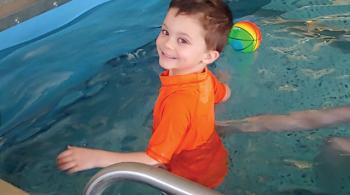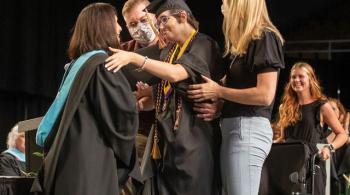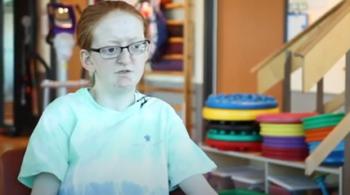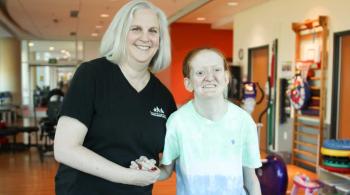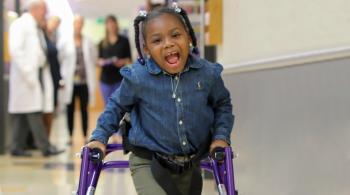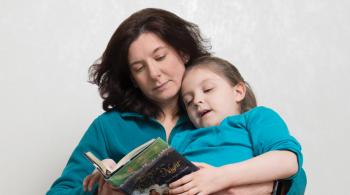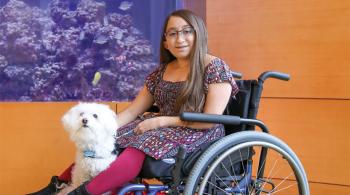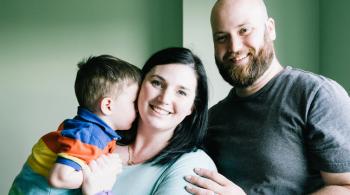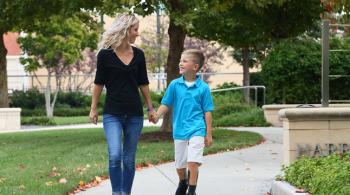Ask 7-year-old Kat what she wants to do when she grows up, and she’ll tell you, as if on cue, “To help hurting children and make them happy!”
Kat—short for Katarina—knows a lot about being happy. She loves playing with her friends, dancing, gymnastics, Legos, animals, the beach, and her close-knit family, which includes three doting older sisters.
But Kat also knows about hurting. Just before Christmas 2015—only a day before she turned 6—she was attacked by two large dogs. The unprovoked attack ripped all five nerves that extend down the length of her left arm from their roots, paralyzing the arm. It also injured her spinal cord, fractured her skull and left her with wounds all over her body.
“Kat technically died on the helicopter ride to the hospital and had to be revived,” says her mom, Sandy, who was seriously injured while trying to save her daughter.
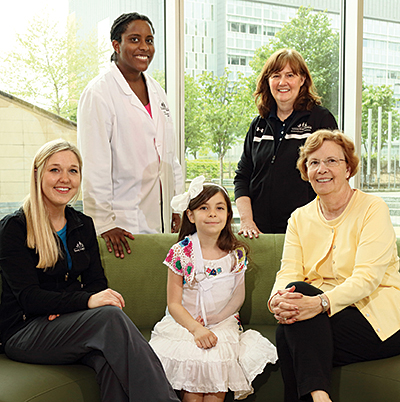
Kat was transported first to a hospital in Virginia, near where the attack happened, then to The Johns Hopkins Hospital in Baltimore for further treatment, and then to Kennedy Krieger Institute’s inpatient hospital, a few blocks away from Johns Hopkins, to begin the long process of rehabilitation.
Her wounds were extensive, and her pain was excruciating. Her left arm’s nerves had suffered the worst possible kind of nerve injury, and nerve pain is far more intense than that of a flesh wound, explains Dr. Eric B. Levey, director of Kennedy Krieger’s Pediatric Pain Rehabilitation Program, and one of the doctors on Kat’s care team.
But it was Kat’s trauma that really worried Sandy. When Kat arrived at Kennedy Krieger, “even though the doctors had saved my daughter’s body, her mind was still trapped in the trauma,” Sandy says.
“She would just stare, blankly, her words frozen, her actions [those] of someone trying to escape from something horrifying.” Hospitals and doctors’ offices naturally became trigger points for post-traumatic stress disorder.
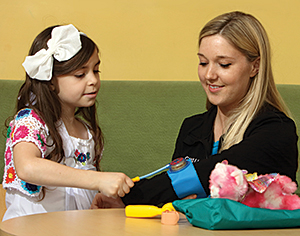
Sandy was suffering from PTSD as well, and she worried how she’d help her daughter recover. Dr. Eboni Lance, a pediatric neurologist and one of Kat’s two attending doctors—the other was pediatric neurologist Dr. Joanna Burton, knew that caring for Kat also meant caring for her family members, “all of whom had experienced significant trauma,” she says.
Dr. Lance briefed members of Kat’s care team about Kat’s and Sandy’s conditions and kept them up to date as Kat’s physical and emotional therapies progressed. It would have been too traumatic for Sandy to have to talk about the attack every time Kat had an appointment.
The extra effort paid off: “It allowed me to step back from what was going on so that I could just be Kat’s mom”—not her medical history chronicler, too.
Ultimately, Kat’s care team included doctors, nurses, therapists and specialists from the Institute’s nursing, behavioral psychology, rehabilitation, child life, and physical and occupational therapy departments, and from Johns Hopkins’ surgery, plastic surgery and neurosurgery departments. Once, when Sandy was sitting at a conference table with several doctors discussing her daughter’s care plan, she started tearing up. Sandy recalls the doctor sitting next to her grabbing her hand and holding on, giving Sandy the emotional support she needed to get through the meeting.
Fairies to the Rescue
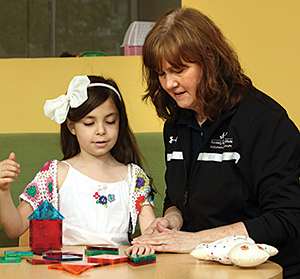
One of Kat’s first tasks was to get up and walking again. She needed to keep her muscles moving so they wouldn’t atrophy, but her mind was still so stuck in the memory of the attack, and she was in so much pain, that she had little desire to do anything.
Kat’s therapists took a playful approach: They dressed up like fairies, dancing around Kat in her wheelchair, encouraging her to take those first, painful steps, Sandy says. Kat’s nurses filled her room with stuffed animals, changing the animals’ locations every day to make the room more interesting and less frightening.

Kat’s psychologists had some of the hardest work to do. “When PTSD took over, Kat would hide, toss her chair, pull my hair, and go back to that moment of survival,” Sandy says.
Her psychologists figured out that she liked checklists, so they developed a checklist of different coping mechanisms Kat could use when she felt anxious. “Kat’s family was really great at encouraging Kat to try out all of the different coping strategies—like deep breathing—that we recommended,” says Dr. Christi Culpepper, a psychologist at Kennedy Krieger.
One day, while Kat was having her blood pressure taken—a big PTSD trigger for her—she looked at the checklist and asked the nurse, “Can you give me a minute, please? I’m having a hard time.”
Now, more than a year later, Sandy says, “we don’t need the checklist anymore.”
No Place Like Home
Kat’s trauma was so acute that Dr. Lance made the decision to discharge Kat from the inpatient hospital only about a month after she’d been admitted. “The best move, for her and her family,” Dr. Lance says, “was going home and continuing her recovery there.”
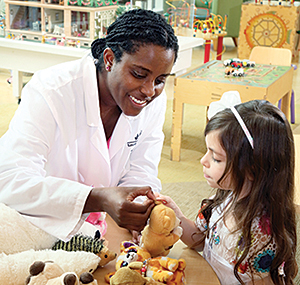
It was better for her family, too. Sandy and her other daughters had become so traumatized by everything that had happened that they were having trouble just walking back to their car in the parking garage. Kennedy Krieger’s security guards “were always ready to escort us,” but it remained a daily stressor.
Being at home helped Kat—and her family—turn a corner. “A big part of Kat’s continued success has been the support she gets from her parents and sisters,” Dr. Lance says. “Without that, I don’t think she would have had the success that she’s had in her recovery.”
Before Kat left the hospital, her occupational therapists trained Sandy in the therapies Kat would need to continue doing. Dr. Lance helped arrange for additional therapy appointments closer to Kat’s home, and she encouraged Sandy to call her whenever she had any questions.
By April 2016, Kat was ready for a nerve transplant to try to restore some function to her paralyzed arm. Johns Hopkins surgeons Dr. Alan Belzberg and Dr. Richard Redett took nerves from her leg and used them to attach nerves from the right and left sides of her neck to damaged nerves in her left arm, explains Dr. Frank Pidcock, Kennedy Krieger’s vice president of rehabilitation.
Over the past few months, after nearly a year of rigorous occupational therapy, Kat’s started to get some feeling back in her left arm, and she can wiggle her left fingers a bit. She’s excited about the prospect of using her arm again, Sandy says.
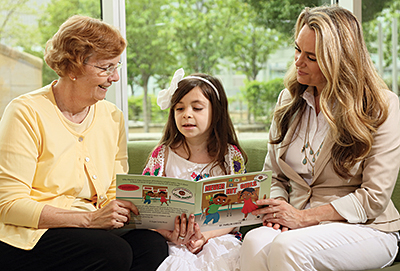
When Kat returned to school last fall, headaches and nerve pain kept sending her to the nurse’s office. Dr. Lance arranged for Patty Porter, one of Kennedy Krieger’s educational specialists, to work with her teachers to schedule rest breaks throughout the day. The breaks keep Kat from developing so much pain that she spends all day in the nurse’s office.
Attending school was crucial to Kat’s recovery, says Dr. Lance, who didn’t want Kat getting used to staying home all day.
By the time her birthday rolled around again, Kat was back. To celebrate, she donated her birthday and Christmas gifts to kids at Kennedy Krieger. She wanted to help the kids feel a little better during what’s supposed to be a festive time of year.
Kat still has a long recovery ahead of her, but as she gave away her gifts, she was no longer a little girl wracked with fear and pain.
She was a strong girl, happy to be getting her old self back, and ready to help other kids get their lives back, too.
Related Departments
To learn more about some of the departments mentioned in this story, visit the following websites for more information:


